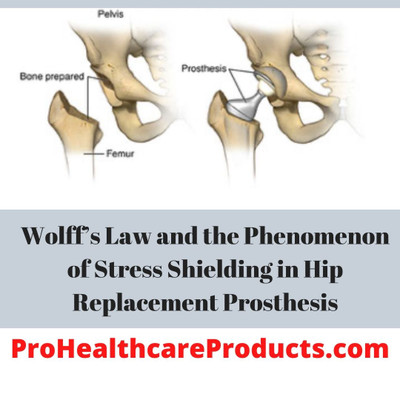 2nd Dec 2021
2nd Dec 2021
Wolff’s Law and the Phenomenon of Stress Shielding in Hip Replacement Prosthesis
Osteoarthritis is a condition that leads to the breakdown of the cartilage that covers the articulating surfaces of the bones that form a joint and is considered one of the leading causes for the need of hip replacement surgery The cartilage serves to protect the articulating surfaces of the bones by reducing friction and absorbing the shock of weight bearing. With osteoarthritis the joint cartilage degeneration typically occurs over years and decades from wear and tear and is therefore mostly manifest as people get older.
Symptoms of Hip Osteoarthritis
The breakdown of the cartilage causes inflammation and pain that can initially manifest itself in various ways making diagnosis difficult. The pain may be felt in the groin, thigh, or knee and may be described as a sharp pain, a dull ache, comes and goes, and may be accompanied by joint stiffness.
Factors that Contribute to the Osteoarthritis Degeneration of the Joint
While there are various causes of hip joint osteoarthritis, leading factors include the chronic stress on the cartilage due to overweight/obesity, genetic inherited cartilage defects, and misalignment of the bones that form the joint.
Treatment of Hip Osteoarthritis
The first line of treatment for hip osteoarthritis is to help control pain, improve a person’s functional ability, and increase support to the hip by strengthening the muscles that act upon the hip joint to produce hip movement. This entails lifestyle modifications to reduce weight if applicable, exercise and other therapeutic intervention to reduce pain and provide support to help prevent further wear and tear on the joint, rest during arthritic flare-ups, possibly taking a nonsteroidal anti-inflammatory drug, etc.
Hip Replacement Surgery
Because osteoarthritis is a progressive disease and will usually worsen overtime, the need for hip replacement surgery becomes a very viable option and recommendation when the pain, and possibly functional limitations, starts to significantly affect one’s lifestyle. In brief, during hip replacement surgery the articulating surfaces of the hip are replaced. The damaged head (ball) of the femur bone is replaced with a metal ball, and the hip socket is resurfaced with a metal shell and a tough plastic liner.

Wolff’s Law and its Potential Impact on Hip Replacement Surgery
Wolff’s Law states that structures (e.g., bone) grow (or diminish) according to the stresses and strains of mechanical forces (both magnitude and directional) habitually placed upon them (or the absence thereof). These mechanical forces such as compression or impact from walking/running or engaging in plyometrics or pulling via muscular contraction applying force to the periosteum of the bone upon which the muscle attaches, produce what is known as the piezoelectric effect. The effect is a slight electric charge is produced in the bone tissue that ultimately causes osteocytes or mature bone cells, to release growth factors that stimulate nearby osteoblast bone cells to produce bony matrix. The end result is that the bone becomes thicker and denser and better able to withstand the forces that are being placed upon it. If, however, these mechanical forces are not placed on a bone, osteoclast bone cells will work to resorb (break down) the bony matrix and the bone becomes weaker and less dense.
Research has shown that the natural mechanical stress applied to a femur bone is significantly altered after a person undergoes hip replacement surgery (called total hip arthroplasty or THA). The metal implant will now carry a portion of the load and result in a reduced amount so stress being born in some regions of the bone. This phenomenon is known as stress shielding. This change and reduction in how the mechanical forces are applied to the bone will result in a loss of bone mass through resorption and will occur around the implant resulting in a loosening of the prosthetic implant.
References
https://pubmed.ncbi.nlm.nih.gov/11006390/ Analysis of a femoral hip prothessi designed to reduce stress shielding
J Biomech 2000 Dec;33(12):1655-62. doi: 10.1016/s0021-9290(00)00110-x.
https://pubmed.ncbi.nlm.nih.gov/1570145/ Failure of cementless fixation of the femoral component in total hip arthroplasty
Orthop Clin North Am. 1992 Apr;23(2):335-46.
Lynn Perkes is a full-time faculty member at Brigham Young University-Idaho teaching courses in Kinesiology and Biomechanics, Applied Kinesiology and Assessment, Therapeutic Exercise, and other Physical Therapist Assistant classes.





